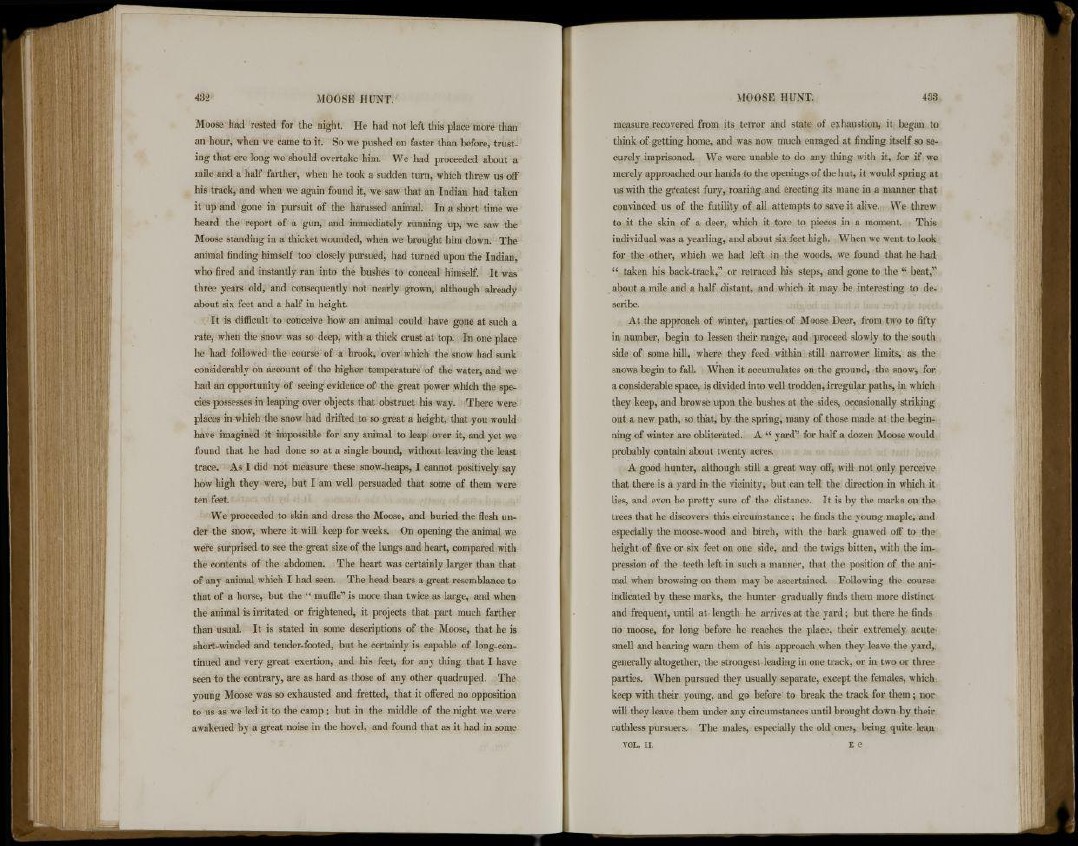
Moose had rested for the night. He had not left this place more than
an hour, when we came to it. So we pushed on faster than before, trusting
that ere long we should overtake him. We had proceeded about a
mile and a half farther, when he took a sudden turn, which threw us off
his track, and when we again found it, we saw that an Indian had taken
it up and gone in pursuit of the harassed animal. In a short time we
heard the report of a gun, and immediately running up, we saw the
Moose standing in a thicket wounded, when we brought him down. The
animal finding himself too closely pursued, had turned upon the Indian,
who fired and instantly ran into the bushes to conceal himself. It was
three years old, and consequently not nearly grown, although already
about six feet and a half in height.
It is difficult to conceive how an animal could have gone at such a
rate, when the snow was so deep, with a thick crust at top. In one place
he had followed the course of a brook, over which the snow had sunk
considerably on account of the higher temperature of the water, and we
had an opportunity of seeing evidence of the great power which the species
possesses in leaping over objects that obstruct his way. There were
places in which the snow had drifted to so great a height, that you would
have imagined it impossible for any animal to leap over it, and yet we
found that he had done so at a single bound, without leaving the least
trace. As I did not measure these snow-heaps, I cannot positively say
how high they were, but I am well persuaded that some of them were
ten feet.
We proceeded to skin and dress the Moose, and buried the flesh under
the snow, where it will keep for weeks. On opening the animal we
were surprised to see the great size of the lungs and heart, compared with
the contents of the abdomen. The heart was certainly larger than that
of any animal which I had seen. The head bears a great resemblance to
that of a horse, but the " muffle" is more than twice as large, and when
the animal is irritated or frightened, it projects that part much farther
than usual. It is stated in some descriptions of the Moose, that he is
short-winded and tender-footed, but he certainly is capable of long-continued
and very great exertion, and his feet, for any thing that I have
seen to the contrary, are as hard as those of any other quadruped. The
young Moose was so exhausted and fretted, that it offered no opposition
to us as we led it to the camp ; but in the middle of the night we were
awakened by a great noise in the hovel, and found that as it had in some
measure recovered from its terror and state of exhaustion, it began to
think of getting home, and was now much enraged at finding itself so securely
imprisoned. We were unable to do any thing with it, for if we
merely approached our hands to the openings of the hut, it would spring at
us with the greatest fury, roaring and erecting its mane in a manner that
convinced us of the futility of all attempts to save it alive. We threw
to it the skin of a deer, which it tore to pieces in a moment. This
individual was a yearling, and about six feet high. When we went to look
for the other, which we had left in the woods, we found that he had
" taken his back-track," or retraced his steps, and gone to the " beat,"
about a mile and a half distant, and which it may be interesting to describe.
At the approach of winter, parties of Moose Deer, from two to fifty
in number, begin to lessen their range, and proceed slowly to the south
side of some hill, where they feed within still narrower limits, as the
snows begin to fall. When it accumulates on the ground, the snow, for
a considerable space, is divided into well trodden, irregular paths, in which
they keep, and browse upon the bushes at the sides, occasionally striking
out a new path, so that, by the spring, many of those made at the beginning
of winter are obliterated. A " yard" for half a dozen Moose would
probably contain about twenty acres.
A good hunter, although still a great way off, will not only perceive
that there is a yard in the vicinity, but can tell the direction in which it
lies, and even be pretty sure of the distance. It is by the marks on the
trees that he discovers this circumstance ; he finds the young maple, and
especially the moose-wood and birch, with the bark gnawed off to the
height of five or six feet on one side, and the twigs bitten, with the impression
of the teeth left in such a manner, that the position of the animal
when browsing on them may be ascertained. Following the course
indicated by these marks, the hunter gradually finds them more distinct
and frequent, until at length he arrives at the yard; but there he finds
no moose, for long before he reaches the plaee, their extremely acute
smell and hearing warn them of his approach when they leave the yard,
generally altogether, the strongest leading in one track, or in two or three
parties. When pursued they usually separate, except the females, which
keep with their young, and go before to break the track for them; nor
will they leave them under any circumstances until brought down by their
ruthless pursuers. The males, especially the old ones, being quite lean
VOL. II. E e